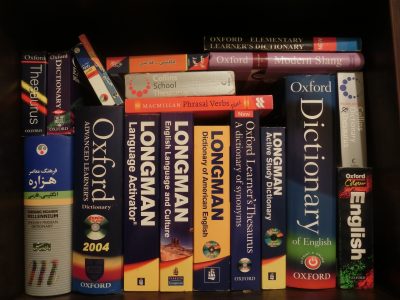By Kaveh Tagharobi
“My sentences are too simple.”
“I can’t write professionally.”
“I need to use more big words.”
Have you heard any of these complaints? Or rather, have you been making them yourself? If so, you are not alone. Many EAL (English as an Additional Language) and non-EAL students find themselves in situations where they feel their academic vocabulary is “just not enough.” Whether prompted by feedback received from instructors and peers or just driven by the desire to impress our readers, we always have this urge to use “different,” “more difficult,” or “more academic” words in our writing. English language is also inviting us to do so. According to the Oxford Dictionaries website, “there are, at the very least, a quarter of a million distinct English words,” and “if distinct senses were counted, the total would probably approach three quarters of a million.” This is more than almost any other language. These statistics alone put a huge pressure on student writers to expand their vocabulary and use a variety of words in their writing. But is this a reasonable expectation, and does using new words always lead to better academic writing?
Let’s consider the following sentence written by an EAL student:
“An illustration of this is the school system, which is one of the main sources of distributing cultural capital.”
At the Centre for Academic Communication, I often see sentences like this. At a first glance, such sentences can be confusing because of their word choice, but with a closer look, it becomes evident that the student has tried to replace a word with a synonym that does not quite work in this context. In the above sentence, the word “illustration” has replaced “example” to avoid repetition. Repetition is something many student writers are concerned about, and rightly so. Academic writing often puts us in situations where we have to repeat the same words over and over again. It is just natural that we prefer not to repeat the same words several times in a short chunk of writing. This reluctance is also enhanced by negative feedback most writers receive about repetition. Another reason words like “example” don’t always get much love is that they are thought to be “too simple.” But is there anything inherently “simple” about the word “example”? It could be that it is shorter than a word like “illustration” and is not an obvious derivative with a formal-sounding suffix. But in reality, what probably makes “example” look simple is the fact that we know it too well; we use it too commonly for it to qualify as a “hard” word, which brings us full circle to the issues of repetition and variety in writing.
But whether these poor “simple” words get discarded for the accusations of simplicity or repetition, what is certain is that many of our students identify the need to have more options when writing. What many student writers and especially EAL writers overlook, however, is that not all synonyms can be used interchangeably. In fact, many synonyms that can be found in thesauri or through MS Word are just similar words that cannot simply replace the original word in the sentence. In such situations, I recommend my students to stick with the words they know rather than trying to add variety to their writing. Common words are common for a reason: they are good words! And repetition is not always bad; it can be a way to consolidate meaning and create consistency. This can be a safe option, but what if they want to improve their writing by using a variety of sentence structures? This is a legitimate need, and there must be a way for it.
This is when I suggest learning academic phrases and sentence structures instead of learning new words.
As counterintuitive as it may sound, learning new “difficult” words is not a priority in improving your academic writing. In my opinion, learning “old” and “simple” word combinations is much more important.
While the previous statistic from OED estimates English words to be at about 750 thousand, other statistics show that of all these words, only a very small percentage are used in everyday writing. The general consensus is that only about 3000 words cover 95% of common texts like newspapers, blogs, and most books[1]. That is only 0.4% of the number OED quotes as the total number of words in English. This means that in order to master the use of words in writing, learning new words like “contumacious” and “gasconading” is not as important as learning how to combine more familiar words such as “for,” “boastful,” “respect,” “in,” “lack,” and “manner.” (see the end for a fun quiz!) Or to return to our example, finding synonyms like “specimen” and “exemplar” (words that are listed as synonyms for “example”) does not necessarily help us with finding alternatives. It is the use of old words like “true” and “case” that makes the difference between intermediate and advanced level writing. Using these words, our student writer could have written the following sentence as a variation of their sentence:
“This is certainly true in the case of schools which are one of the main sources of distributing cultural capital.”
But where do these combinations come from? How can student writers learn such academic phrases and add them to their repertoire of active vocabulary? We certainly cannot just make new collocations ourselves. Learning a language is one of the very few areas of knowledge in which being inventive is not always a recipe for success. Surprisingly, here, imitation and copying are more fruitful ways of learning and improving. We have to have encountered a certain arrangement of words to be able to reproduce it in our writing.
Therefore, my first suggestion to learn new collocations is to look for them in other people’s texts. Instead of going to vocabulary books or resources that introduce phrases and collocations, you can look for, notice, and try to learn such collocations while reading and listening. Academic articles, books, lectures, and more general texts like news articles, podcasts, and even daily conversations are great sources to find and learn new collocations, phrases, and sentence structures. This can make learning new collocations part of your daily routine without the need for setting aside dedicated time for it. You can form a habit to treat your daily reading and listening activities as learning opportunities to expand your vocabulary circle.
But to do this, first you need to develop an eye for finding useful collocations in written and spoken texts. In other words, you have to learn how to identify word combinations that might look ordinary at the first glance but are in fact specific arrangements of words that you would not normally use in your writing. To give you an example, look at this short excerpt from an academic article[2] on Digital Humanities:
“This essay traces some of the ways modernism and digital humanities have converged of late. It covers some of the key modes in which that convergence has so far found expression.”
They seem like a couple of normal-looking sentences with apparently no “difficult” or “fancy” words. However, with a closer look, you can notice that the authors have used the words “of” and “late” to mean “recently.” This is a very simple word combination; but despite its simplicity, it is an arrangement that an EAL writer would not necessarily know or use. Similarly, the words “found” and “expression”, two more seemingly “easy” words, have constituted a collocation that can replace words like “show,” “demonstrate,’ or “manifest,” all words that student writers overuse and would want to find synonyms for. With more attention, it becomes evident that the collocation “find expression” is used with the preposition “in” and is followed by a noun, but in this sentence, the preposition and the noun have moved before the verb. Therefore, the complete expression that we should extract from this sentence is “to find expression in something.” As you see, this requires attention and bit of experience, but with some practice, you can easily mine valuable collocations by just analyzing ordinary-looking sentences.
Finally, remember that the type and usage of the collocations you find will vary based on the sources where you find them. What you will find in a magazine article or a podcast can be fairly informal and suitable for daily situations. In the same way, if you review academic texts, like journal articles and books, you are more likely to find collocations that are useful for your academic writing.
So far, we discussed the ways to identify new collocations in others’ texts. In a next blog post, I will talk about developing a system to record, practice, and finally master the newly-learned collocations.
And now is the time for this post’s quick quiz. What sentences would you make with the “simple” words “for,” “boastful,” “respect,” “in,” “lack,” and “manner” I proposed to use instead of “contumacious” and “gasconading”? Comment on this post if you want to play!
[1] Fry, E. B., 1925, & Kress, J. E. (2006). The reading teacher’s book of lists (5th, 1st ed.). San Francisco, CA: Jossey-Bass.
[2] Ross, S., & Sayers, J. (2014). Modernism meets digital humanities. Literature Compass, 11(9), 625-633. doi:10.1111/lic3.12174
Credit for photo of books: https://commons.wikimedia.org/wiki/User:Alborzagros#/media/File:English-English_and_English-Persian_dictionaries.JPG
About Kaveh

Kaveh Tagharobi has two MA degrees in English, the second one completed at UVic in 2017 with a concentration in Cultural, Social, and Political Thought (CSPT). Before starting to work at the CAC in 2013, he was an ESL/EFL instructor for 10 years in Iran, teaching a variety of topics to high school, undergraduate, and graduate students. At the CAC, Kaveh works with both international and domestic students, helping them to plan their research, organize their writing, edit for grammar, and improve their reading and critical thinking skills.